Creating Facebook audiences to optimize facebook ads campaigns isn’t rocket science, but with the almost infinite possibilities of targeting options available, it can get complex.
To succeed in your advertising campaigns, promote your products and get a good ROI on Facebook (return on your advertising spend), you need to focus your budget so that only relevant, qualified audiences see your ads. So how do you find the right audiences on Facebook, whatever your sector and type of activity?
In this article we will explain :
– How targeting works on Facebook
– How to optimize your ad sets for success
– And how to use Facebook Business Suite to learn more about your prospects
Here we go!
Introduction to audience targeting on Facebook
Typically, someone typing “buy fine point pens” into Google is looking for particularly fine writing utensils.
But on Facebook, while an incredible range of information can be harnessed to create hyper-granular audiences, the intentional component is generally not present.
Facebook doesn’t offer keyword targeting. You need to define an audience that is sensitive to your products, to which you want to deliver your ads. It’s a complete paradigm shift from Google Ads campaigns.
That’s not to say that Facebook advertising isn’t useful. Quite the contrary. It’s a source of opportunity for all advertisers, B2C and B2B alike.
Facebook lets you attract audiences and people interested in your products or services, and nurture them with dynamic, engaging content, from initial exposure to the day you can close a deal.
Of course, to be effective, you need to have a thorough knowledge of who you’re targeting and, above all, how you’re targeting them.
It’s all about striking a balance between broad and specific audiences, effectively transforming your Facebook advertising efforts into a self-sustaining marketing funnel.
Promote your brand and products with broad Facebook targeting
Targeting large audiences with Facebook ads is the best solution for new campaigns, brand awareness and data collection.
Extended targeting gives Facebook a great deal of power. You have to trust it to algorithmically determine which subsets of humanity might be suitable for your product or service.
Although it can be scary to cast a wide net, this approach can help you find potential customers you’d never have suspected existed otherwise. You can also use the data you glean from targeting a broad audience to formulate more specific audiences down theconversion funnel.
Broad targeting, followed by a search in Facebook Business Suite and your reports will give you a better picture of the Facebook users who interact with your ads in a positive way.
By using overlapping demographic and psycho-graphic characteristics, you can associate new, optimized core audiences with targeted ad creatives to drive more conversions.
Broad Facebook audience targeting in action
Let’s imagine you’re selling high-quality hats to people living in the USA. They’re woven from the silkiest alpaca yarn. They come with a small leather patch featuring your logo. They retail for $59.
You’re looking to take your Urban / Hipster clothing brand to the next level.
It’s time to start spreading the word, and there’s no better way to do it than through advertising and your Facebook campaigns.
Now, it would make no sense to target people of all ages all over France…
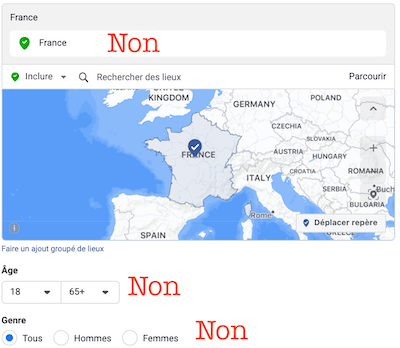
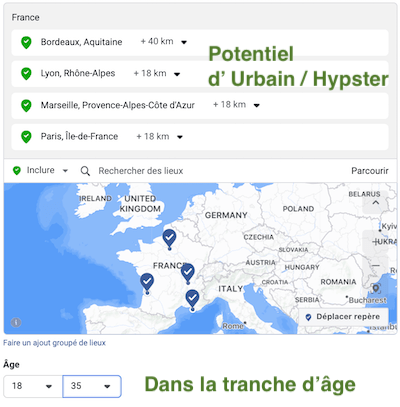
Now, a few words of caution.
You’re not going to be satisfied with this targeting in perpetuity. The aim is to use it to inform certain more targeted audiences to whom you’ll advertise with attractive, specific creations.
Think of this broad targeting as Facebook’s equivalent of the Display Network or a well-placed billboard.
By combining this information-gathering and brand-building strategy with more sales-oriented targeting down the funnel, you can create a steady stream of leads for your business.
It shouldn’t take up a large part of your overall advertising budget, but by allocating a percentage of your Facebook spend to large audiences like this, your business can benefit from the intelligence of Facebook’s advertising algorithm.
Expanded targeting will expose your brand to new prospects: people who would never have heard of you otherwise.
That said, your advertising and your offer will need to align with the lack of intent of your extended audiences. Your goal here isn’t to sell a hat or close a deal the same day: it’s to gain visibility and fill your funnel.
From there, you can create new personalized audiences, steering Facebook users towards a purchase as you learn more about their characteristics, wants and needs.
While you’re likely to get higher engagement using broad targeting (simply because of the number of people you’ll reach), the majority of your Facebook advertising budget should be allocated to targeted audiences that will have real business value.
Speaking of which…
Optimize your ROI with specific Facebook audiences
Targeting specific audiences with Facebook ads is the best way to achieve profitable conversions.
In fact, by targeting specific audiences, you give Facebook a strict set of parameters to deliver your advertising package to a subset of users potentially interested in your offer and products.
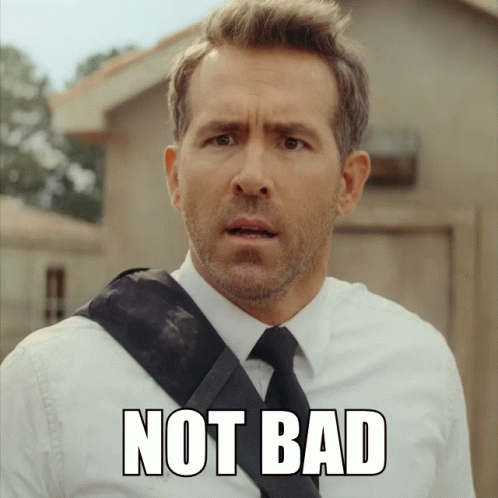
Here are some of the ways you can define these more specific audiences:
– Make a list of the professional positions your customers tend to occupy, associate it with an affinity for the products you’ll be selling, e.g. Food or Cultural, then overlay it with specific locations.
– Leverage personalized audiences based on actions carried out on your website, such as newsletter subscriptions, time spent on your site or, of course, those who add to their shopping cart.
– Create a 1% audience by using your most profitable customers as your core audience.
These methods (and an infinite combination of other specific targeting methods) can help you skip a few steps between the moment a prospect says “hmm, that sounds good” and the moment they enter their credit card number to buy your product.
By drastically reducing the number of people in each audience, you can tailor your creative to the characteristics and actions of a group of prospects you’ve created, improving your chances of success.
Of course, you also significantly reduce your ability to reach large swathes of the Facebook user audience.
That’s why it’s important to combine broad and specific audiences, using the former to channel new prospects to the latter.
Specific audience targeting on Facebook in action
As you already know, there are countless ways to define an audience on Facebook.
The term “specific” does not explicitly refer to the use of personalized or “lookalike” audiences, but rather to a well-defined set of Facebook users.
Basically, anything that maximizes audience targeting can be defined as “specific” audience targeting.
The three main ways to achieve this are :
- targeting by level
- personalized audiences
- similar audiences
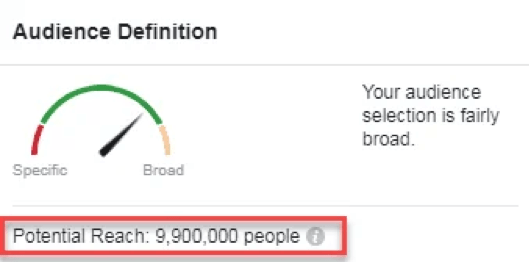
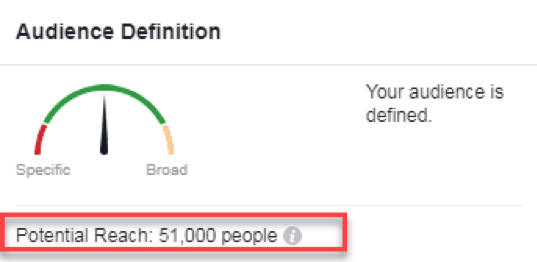
1- Targeting by level
Facebook lets you overlay a myriad of targeting options to create new granular audiences.
The advantage of this method is obvious: you can tailor and personalize your advertising to the characteristics of small, overlapping audiences to show your prospects how your product or service meets a specific need.
For example, if you’re selling home insurance, you’ll want to target people who have recently bought a house.
But more specifically, you can use the tiered audience to create variations in the audience of new homeowners based on characteristics such as house type (apartment, townhouse, house with garden), property value and household composition.
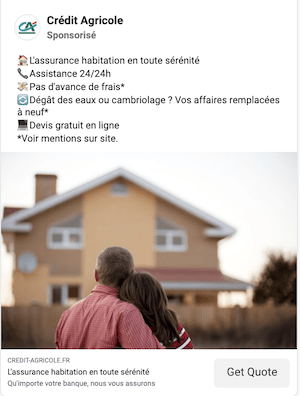
This Crédit Agricole ad, for example, would be perfect for people who’ve just bought a house, but completely useless for apartment dwellers who wouldn’t recognize themselves in the advertising image.
By dividing recent home buyers into segments using tiered targeting, you can deliver completely different ads to the 20-year-old couple buying a one-bedroom apartment in Paris, the family of five in the South-West, and the recent divorcee with a seaside apartment in Cannes.
Producing creatives that are specific and personalized to your personas can be an excellent way of increasing conversions in the middle of your sales funnel.
2- Customized audiences
Personalized audiences allow you to target Facebook users based on the following:
– Your customer file (the e-mail addresses you upload)
– Your website traffic (provided the Facebook pixel is present on your site)
– Application activity (pretend it doesn’t exist)
– Engagement (explicit action on Facebook or Instagram)
Of the four possible sources for personalized audiences, the most valuable are, without doubt, customer files and website traffic.
Note that personalized audiences are often the smallest audiences you can create on Facebook.
This makes it difficult for Facebook to distribute your creations unless they reach supreme levels of engagement, as reflected in the relevance scores of your Facebook ads.
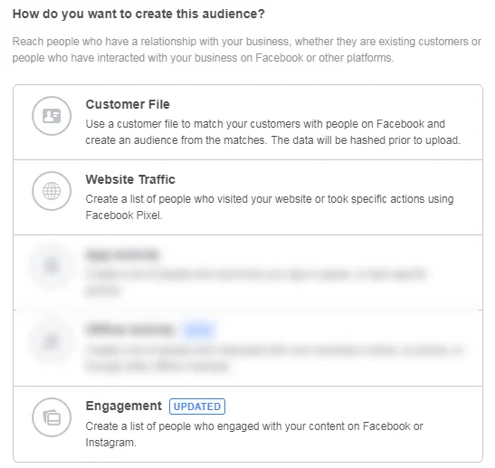
The “client” component of customer file audiences is not essential: you can download any list of e-mail addresses and reach Facebook users whose e-mail address identifiers match.
Use these personalized audiences to upsell to existing customers, offer a product demonstration to people who have downloaded specific content: the possibilities are endless.
Ditto for personalized audiences generated from your website’s traffic: use Google Analytics to determine which pages people tend to visit, make sure the Facebook pixel is on those pages, create an audience and serve ads that expand on the content prospects have viewed.
3- Similar audiences
Facebook Similar Audiences are the icing on the cake of Facebook advertising.
While personalized audiences are generally limited – since you have to upload a list or supply users based on actions taken on the application site – similar audiences are simply aggregated users whose characteristics mirror those of a selected source audience.
The degree of correspondence can be modified (1% representing a near-facsimile and 10% a second cousin).
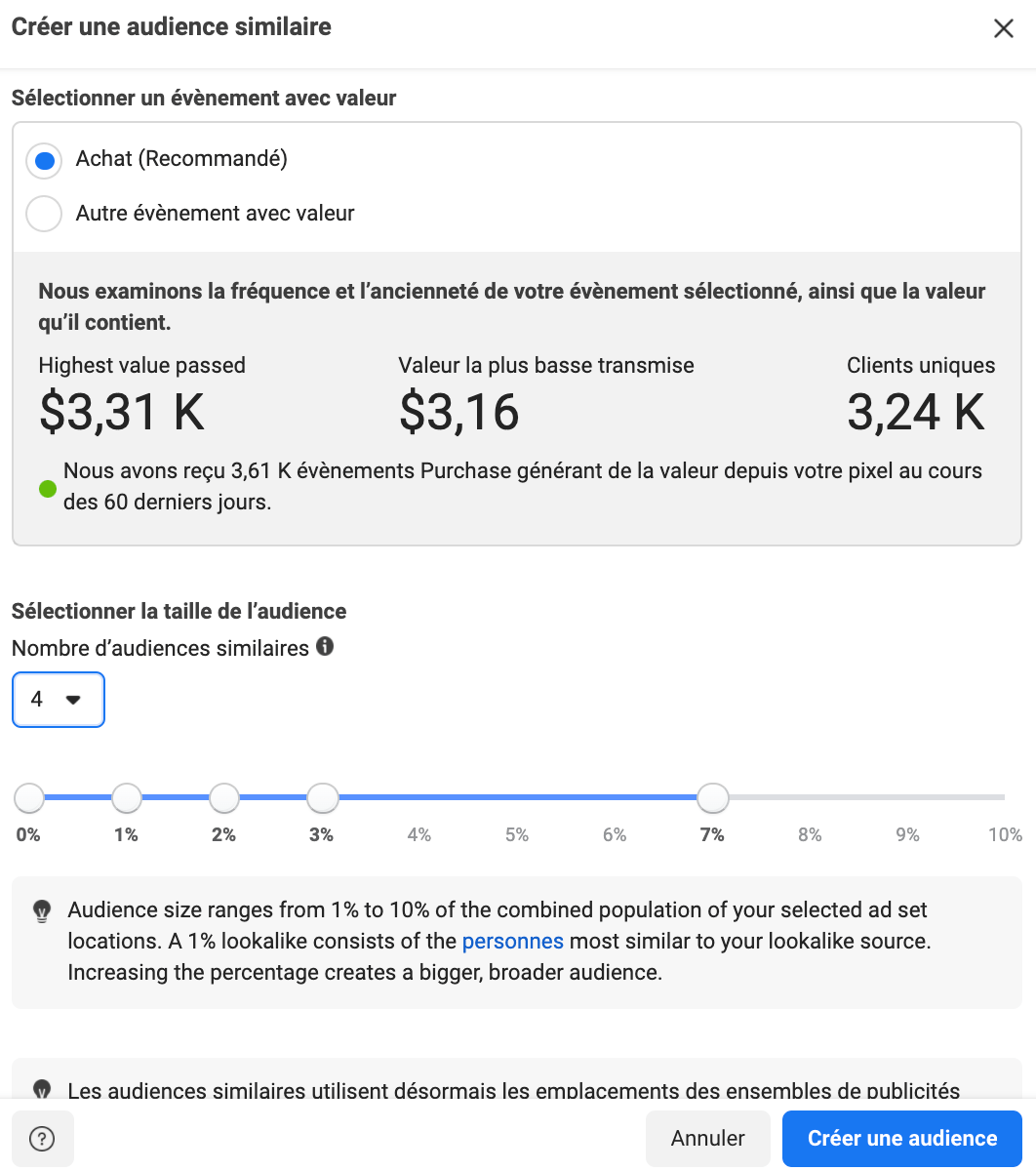
The “source” audience for your lookalikes can be any Facebook audience you’ve already created;
To maximize their value, however, you should use converters, based on the Facebook Pixel, or customer e-mail addresses.
In the example above, the source is the buyers, identified by the pixel.
There’s no point in creating a lookalike of people who, having seen an ad as a member of one of your larger audiences, haven’t interacted with it, or interacted negatively.
In brief
– Similar audiences are one of the most effective ways to get immediate value from Facebook ads.
– Tiered audiences are a great way to take advantage of Facebook’s inherent intelligence without spending a lot of money.
– Finally, personalized audiences are the ideal way to activate mid- and lower-level audiences in your Facebook advertising strategy.
Now that you know the differences between broad and specific targeting of Facebook audiences, here are three tips to help you use them more effectively.
Statistical significance refers to the point at which you have accumulated enough data to make an informed decision about performance. It’s essential for both broad and specific audiences, but for very different reasons.
With extended audiences, you need to determine and act quickly on statistical significance to avoid wasting ad spend on whole swathes of tangibly interested Facebook users.
This is where Facebook Business Suite can really become an invaluable tool in your arsenal.
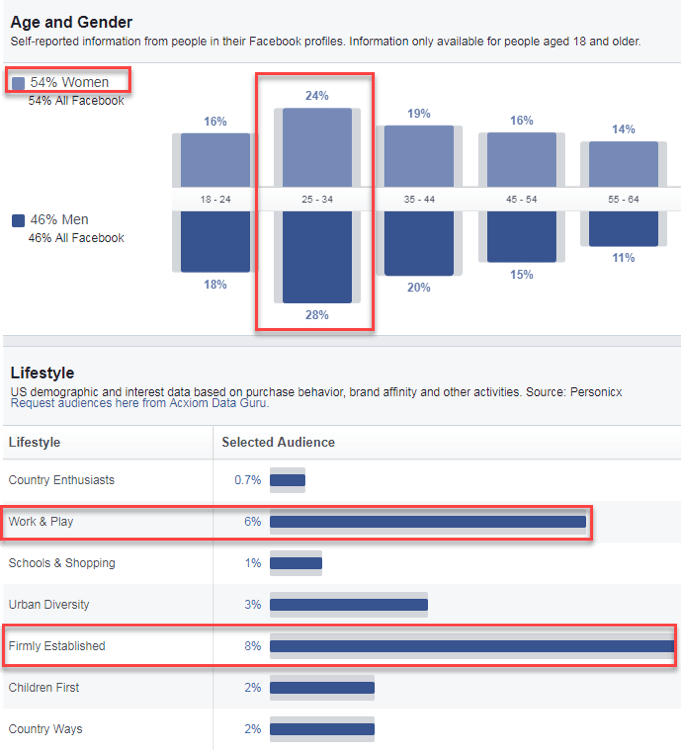
When it comes to more specific audiences, those likely to get conversions quickly, tailoring your targeting and ad creative based on performance will ensure that small, valuable audiences aren’t frustrated by your efforts.
This is the best way to determine whether or not an audience is working, and therefore to begin the never-ending process of optimizing Facebook conversion rates.
It can be tempting to divide your campaigns into dozens of ad sets based on this information. According to Facebook, this is a big NO:
“You want to segment your campaign into several smaller ad sets to see which one performs best and use that as a template for future ad sets. However, with so many ad sets, it’s unlikely you’ll get a statistically significant number of results for any of them anyway.”
Too wide and you’re background noise. Too narrow and meaning is unattainable. To counter this, use engagement data from both broad and specific audiences to inform your ad creative.
If something isn’t working at all, use this audience information to modify your targeting and re-engage your prospects.
As I said above, sources such as comments on articles or engagement on the Facebook business page are not viable bases for your sister audiences on Facebook.
There’s no way of knowing whether their features represent a discernible commercial value that you’d like to reflect. But that’s not the only problem. Lookalike audiences tend to be too small.
Use the most valuable sources at your disposal to create look-alike audiences.
Leverage the Facebook pixel and your CRM’s proprietary data to distinguish between people who say “oh great, a link [cliquez] eh” and those who have already paid for your product or service.
If you’re an experienced advertiser with a large amount of data at your disposal, you can take this discerning attitude even further.
Distinguish between customers and major customers (those who spend the most, etc.) and create similar audiences for both groups. The first group can function as a large audience. The second, a specific audience. As soon as they populate, you’ve got gas to spare.
This is related to our last point, but it bears repeating: quality is greater than quantity. Final point. A key way of determining quality (apart from conversions and revenue) is to check relevance scores.
The relevance score is Facebook’s measure of the quality and level of engagement of your ads. Your relevance score is important because it determines both your cost per click on Facebook and the frequency with which Facebook displays your ad.
While it can be difficult to maintain a solid relevance score across a broadly-targeted set of ads, it’s not impossible: all you need to do is understand your audience and test perpetually.
Combined with a compelling offer and attractive advertising creative, a quality audience of 100 is better than 10,000 strangers every day of the week.
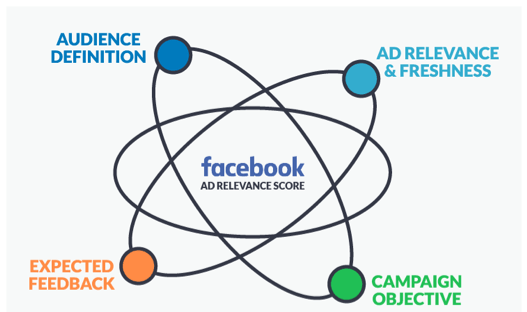
Finally
Remember: introduce your brand to a range of prospects by targeting a broad audience, then sell to them by targeting a specific audience.
Facebook ads aren’t easy to understand, but if you understand audience building and implement a consistent targeting strategy, you’ll be well on your way to success in paid social.
And don’t forget to set up remarketing lists that will allow you to serve ads to your “hot” audiences or reactivate your customers 😉
If you need more advice and want to delegate your Facebook campapgnes and Instagram campaigns, our social media experts will support you in your developments.



